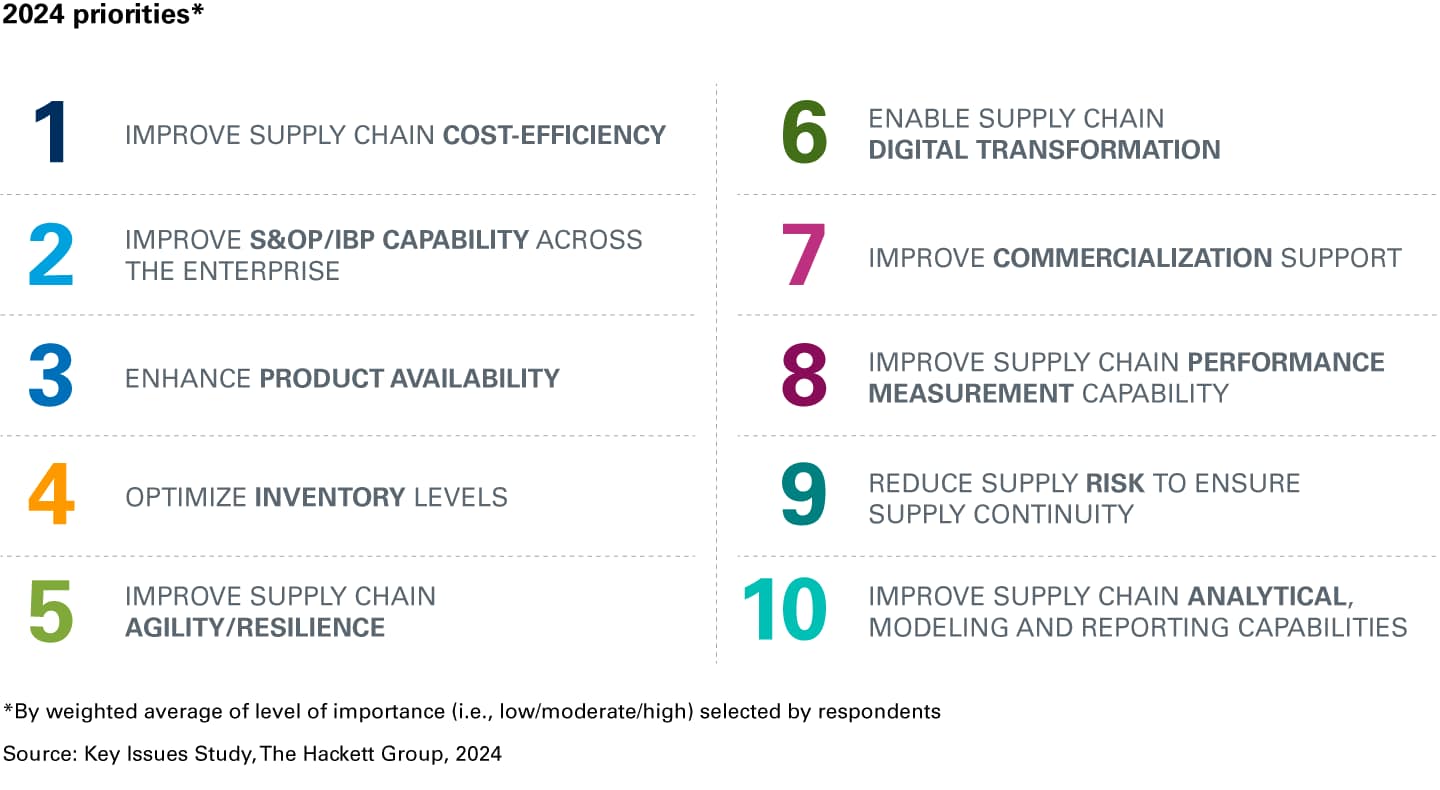
The Supply Chain Agenda: 2024 Supply Chain Key Issues
Expectations placed on supply chain teams by businesses remain elevated. This challenge is not new to the supply chain function, but in the face of continuing economic and geopolitical uncertainty, teams are feeling increased pressure to do more with less. As experts predict a stall or slowdown for global economic growth in 2024, our findings from The Hackett Group’s 2024 Key Issues Study indicate that supply chain leaders have shifted their priorities for this year.
What’s changed
The top priority for supply chain leaders for 2024 is improving cost-efficiency. Other returning priorities to the top five are improving sales and operations planning (S&OP), enhancing product availability and optimizing inventory. These priorities are consistent with cross-functional executives’ top 2024 objective to improve and protect margins given concerns with recession risk, rising interest rates and labor shortages/skill gaps.
New to the top five priorities in 2024 is improving supply chain agility and resiliency. This is not surprising given the focus in recent years on implementing supply risk mitigation strategies based on lessons learned from COVID-19, weather-related disasters, geopolitical conflicts, etc.

Cost-efficiency dominates risk mitigation strategies
Eighty-three percent of survey respondents said it is likely or highly likely that they will focus on making processes more efficient – making it the top risk mitigation strategy planned for 2024. Close behind is increased process automation. Both underscore the continued cost and productivity pressures experienced by organizations. Working capital optimization is also a top risk mitigation strategy for organizations managing historically high interest rates.
Already facing significant challenges to be more resilient and agile, supply chain leaders are also preparing for another demanding year of having to do more across planning, manufacturing/production and delivery/logistics without comparable increases in staffing or budget.
Focusing on inventory and working capital optimization will build resiliency
Becoming an agile enterprise that can adapt quickly is increasingly important for businesses, but it requires developing agile behavior at the process level. Being able to pivot to support new stakeholder and marketplace requirements is critical to effectively support business objectives and customer satisfaction levels.
Matching supply requirements to demand has become more challenging given recent spikes in demand – both up and down – that limit the ability to use historical performance as a predictor of the future. To be resilient amid demand shocks and supply disruptions due to both expected and unexpected events, supply chains must incorporate demand sensing of nearer-term activity using tools such as artificial intelligence (AI) to derive insights from large, complex datasets. Additionally, working capital optimization, which includes inventory, is a top risk mitigation strategy for organizations.
Organizations can improve efficiencies through digital transformation
Supply chain planning technology is deemed a key enabler of the top 2024 priorities to optimize inventory, reduce supply chain risk, improve product availability and improve S&OP/integrated business planning (IBP) – all while improving supply chain cost-efficiency. Despite the recent emergence of generative AI (Gen AI), 33% of supply chain teams have already adopted it, and adoption is expected to grow to 48% in 2024 via pilot deployments. Of those supply chain organizations evaluating Gen AI, the most promising opportunity area is planning.

Supply chain organizations must have a seat at the table for new product processes
Supply chain performance plays a critical role in the new product development process because it not only drives the investment of capital into production and distribution capabilities, but also in many cases determines the critical path for launch dates. By including supply chain experts early in the new product development process, critical questions can be addressed before a product passes through the various stage gates from concept to launch to assess its viability.
Key metric performance highlights the need for a more resilient supply chain
Transparency across the supply chain and a balanced set of key performance indicators/targets to monitor planning, supply continuity, and execution performance depend on improving analytic and reporting capabilities. Organizations need to monitor revenue, margin and recovery impacts tied to supply chain process to understand the cost/return on investment of pursuing (or not pursuing) supply chain resiliency efforts and resulting decision-making.

Risk mitigation key to supporting supply chain resiliency
Reducing supply chain risk fell from the No. 2 position last year but remains key to supporting supply chain resiliency. Many organizations have established risk mitigation practices, such as optimizing inventory buffers, qualifying vendors and strengthening supplier relationships based on lessons learned from COVID-19, geopolitical conflicts, climate-related disasters, and cyberattacks.
Achieving top priorities depends on analytical and reporting capabilities
The potential of supply chain analytics is key to supporting this year’s top priorities to inform strategic decision-making and enhancing effective and efficient supply chain performance. While adoption of supply chain strategy and analytics and data visualization tools skew to pilot or small-scale deployments and is not expected to grow in 2024, supply chain leaders do rate these tools as providing strong value.
Doing more with less: avoiding productivity and efficiency gaps
Almost 50% of supply organizations have a planned 2024 initiative to develop or acquire new skills and talent. Yet, the 2024 Key Issues Study confirms what supply chain executives already know: They must find a way to do more with less. Workload is expected to grow by about 3% to 5% across the supply chain – planning, manufacturing/production and delivery/logistics – in 2024, with relatively flat changes to both head count and operating budgets, leading to productivity and efficiency gaps. Supply chain leaders still have a significant challenge in front of them. Indeed, 83% of executive respondents across the enterprise cite that it is likely or highly likely that they will focus on making processes more efficient – making it the top risk mitigation strategy planned for 2024.
Transform your technology capabilities in 2024
As economic and other disruptions remain a feature of the outlook for 2024, supply chain organizations will need to adjust their priorities to ensure that they are able to support supply continuity and service levels cost-effectively. We believe most supply chain teams can make meaningful progress toward achieving their 2024 priorities by focusing on five areas:
- Stay focused on the customer.
- Invest in digital transformation wisely.
- Close the digital knowledge and skills gaps.
- Turn data into insight.
- Drive sustainable cost reduction.
Download the full report to get recommendations and learn more about the top priorities of supply chain executives for 2024, including improving cost-efficiency, improving S&OP/IBP, enhancing product availability, optimizing inventory and improving supply chain agility/resilience.



